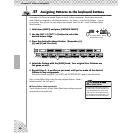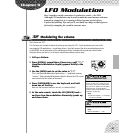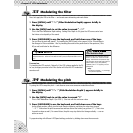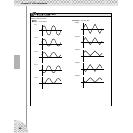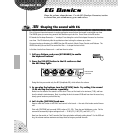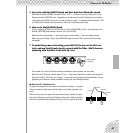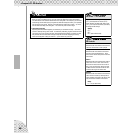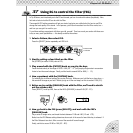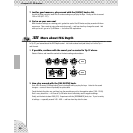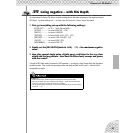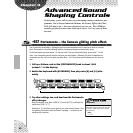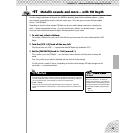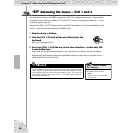
47
Chapter 10 EG Basics
5 Next, play with the [DECAY] knob and hear how that affects the sound.
Make sure to reset [SUSTAIN] to around 10:00 or 11:00 — if Sustain is too high, Decay won’t work!
Experiment with the [DECAY] knob. Depending on the Voice and the other EG settings, a short Decay
value (knob around 9:00) may result in a weak, percussive sound. Try adjusting the knob around 11:00
or 12:00 and then slowly move upwards from that as you repeatedly play the key.
6 Now, on to the [RELEASE] knob.
Start by resetting [ATTACK] to 7:00, [DECAY] to 11:00, and [SUSTAIN] to 1:00. Then experiment with
different [RELEASE] knob settings, such as 1:00, 3:00 and 5:00.
Notice that the sound sustains — longer and longer for each setting — after you release the note.
Before you go on to Step 7 below, bring [RELEASE] back to around 1:00, and leave the other knobs
unchanged.
7 To make things more interesting, press [SELECT] to turn on the FEG con-
trols, and use the EG knobs to play around with the filter. (We’ll do more
exploring with the filter in the next tip, too.)
Play around with the four EG knobs and hear what kinds of sonic mayhem you can create.
Work with the VCF section controls (page 27), too — they have a huge effect on the overall sound and
behavior of the EG. We’ll warn you, though — the results can be complex and unpredicatable. But we
guarantee you’ll discover a whole truckload of sounds you never thought possible.
● What is an EG? What does it do?
To explain by example, let’s take a look at an acoustic instrument — the piano.
The piano doesn’t actually have any EGs inside, but the basic principle is the
same.
When you hit a key on the piano, the sound starts sharply (Attack), but goes
down soon (Decay) to a softer level (Sustain) as the note is held, and quickly
dies out to complete silence (Release) when you lift your finger from the key.
Indicates FEG
is selected.
ATTACK
RELEASE
SUSTAIN
DECAY




